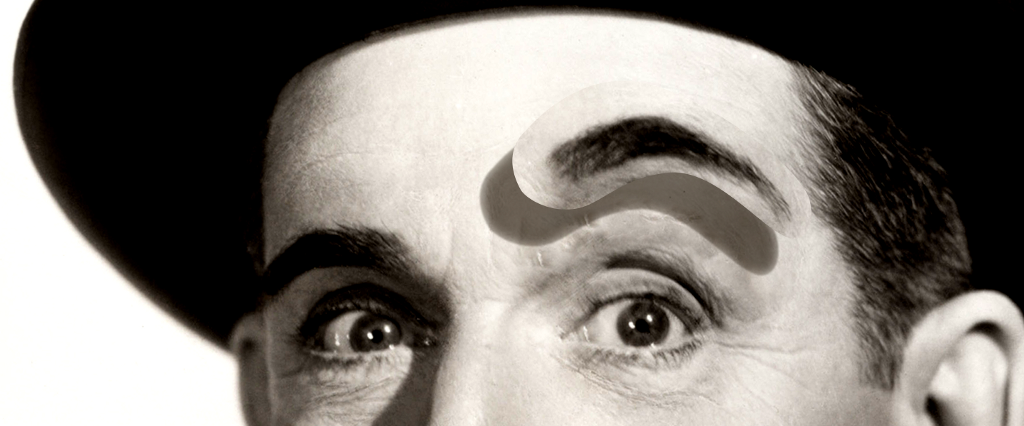The message carved into Ernie’s high school locker was clear: “Ernie has no eyebrows and a frying pan forehead.” Now 24, Ernie tells me that he’s “reasonably good looking and fit,” save for, of course, the non-existent brows. Ernie tried to fill them in with his girlfriend’s eyeliner, but they were too sparse to color. “Is there anything I can do?” he wondered in the MakeupAddiction subreddit. “I just want to look good and manly.” Ernie says naturally defined, thick eyebrows frame the face, and he thinks “99 percent of men in the public eye” have them. Just look at male model Edward Wilding, he suggests.
Absent anything close to Wilding’s “robust, shapely brows,” Ernie opts to live vicariously through FaceApp, a Russian face transformation program that allows him create thicker, darker eyebrows that “look 100x better.” A recent screenshotted before-and-after:
Johnny, a 52-year-old Floridian, longs for the same. Whenever he meets someone, the first and second things he notices are their eyes and their eyebrows. That’s why his “feminine, unpronounced” pair always leave him feeling naked and exposed. And so, he’s gone far beyond Russian apps to get his dream pair. It began with a Google search for “eyebrow transplantation,” which led him to Miami plastic surgeons Jeffrey Epstein and Anthony Bared, who along with Marc Dauer pioneered eyebrow transplantation in the late 2000s. (That said: The very first eyebrow transplant was actually done in 1937 by a Japanese dermatologist named Shoji Okuda.)
“The three of us do way more than anyone in the world,” Dauer explains about the procedure, which typically ranges in cost from $4,000 to $10,000 depending upon the severity of the job and the number of follicle incisions. While it was almost exclusively women swapping out their forehead caterpillars a decade ago, these days men represent a third of Dauer’s eyebrow transplant patients. Basically, as men have seen how effective botox, fillers and manscaping can be, they’re likewise realizing that eyebrows are the most important feature on their face. As grooming expert Stephen Handisides tells me, “Just as the eyes are the window to the soul, eyebrows frame and the shape the face. Thickness and color can dramatically change your appearance — for the better or the worse!”
Eyebrow transplantation, however, isn’t like Mr. Potato Head — i.e., you can’t just pop them on and off. The procedure typically takes eight to ten hours while each hair follicle is harvested — one by one — from the back of the head, and implanted — one by one — at just the right angle. “The subtleties and small details are the difference between a good and bad procedure,” Dauer says. “You can’t hide mistakes in the eyebrows.”
Because Johnny spends half the year in Florida, he opted to have the procedure done in Miami with Bared, a quarter of whose eyebrow patients are men. After numbing the base of his scalp, Bared removed 275 hairs from the back of Johnny’s scalp and placed each under a microscope. After nearly 300 follicles were separated and washed, they were inserted in the brow at just the right angle so as to not grow straight out, a common blunder with brow transplants. It’s all done under local anesthesia, so Johnny was awake for the entirety of the eight hours but felt no pain. (He was swollen and bruised around the eyes for a fews days, and other patients have reported mild discomfort.)
After three weeks, like leaves on an autumnal oak, the sapless follicles fell out. Then, three months later, the planted seeds began to bear fruit — as they will do forevermore. Soon, the bumper crop necessitated biweekly pruning. Bared reminded Johnny that since the grafts were taken from the scalp, they would grow faster and require more frequent trimming, which Johnny likened to erectile dysfunction patients being “warned” that their erections might last up to four hours after taking Cialis.
Not everyone is bullish on the bogus brows, though. While New York eyebrow specialist Sania Vuceta agrees they’re crucial to frame the face, she says the biggest mistake men make is going too far — a frequent byproduct of transplantation. Besides, she explains, transplantation doesn’t look natural because there’s no way to plant the follicles closely enough to avoid sparsity. Also, the more you trim them, the coarser the hairs will get, eventually requiring twice daily trimming. “You can imagine how scary it is to have out-of-control eyebrows sprouting as fast as the back of your hair,” Vuceta says. “It’s not a great look.”
Sanusi Umar, a hair restoration surgeon and dermatologist in Redondo Beach, CA, introduced an alternative in 2014 by performing the world’s first eyebrow transplant using body hair as opposed to scalp hair. With Umar’s patented Dr.UGraft™ transplant system, donor eyebrow hair could be extracted from anywhere that most closely resembled and behaved like the patient’s eyebrows, which often is the pubes. “Pubic hair can definitely be used in an eyebrow transplant,” Umar writes via email. “It’s especially suitable for individuals whose natural eyebrow hair is curly and coarse.”
There are, of course, alternatives to transplantation, most notably microblading, a semi-permanent tattooing technique to fill in thinning brows. But while Johnny is familiar with microblading, he’s not interested in what he calls a “tiny ink dagger” slicing through his forehead. “Microblading is horrible,” agrees Vuceta. Because few people have experience shaping brows, permanent errors are common. They’ll eventually fade to a strange purplish blue hue that you’re stuck with for the rest of your life. “It’s a horrible idea,” Vuceta repeats. “Especially on the face.”
Instead, she suggests men get over their irrational fear of makeup and pick up an eyebrow pencil, like the one she designed while working at Bergdorf Goodman. “All these steps people are taking are a lot scarier and more expensive than a natural pencil,” she says. “At the end of the day, it’s all about being natural.”
Or it seems, faking natural as naturally as possible.

